In the Kansas towns of Leoti and Tribune, community members and city officials are taking steps toward addressing the potential lack of water in future years. With a recently awarded $250,000 grant from the Wildlife Conservation Society (WCS) Climate Adaptation Fund, PLJV will continue to collaborate with the two communities to include playa restoration in these efforts and export the model to other towns.
“It’s exciting that we can do wildlife work that is combined with supporting communities and society in general.”
Funding from the WCS grant will be used to restore playas near municipal and domestic wells in Wichita and Greeley counties. Starting with these towns, the Playas Recharging Kansas Communities project, also referred to locally as the Groundwater Recharge and Sustainability Project, will focus on playa restoration that will provide more and cleaner water to the Ogallala aquifer for the people living in these communities, as well as provide critical habitat for wetland birds.
“Increasingly, our wildlife goals are becoming more closely aligned with societal goals,” said PLJV Coordinator Mike Carter. “It’s exciting that we can do wildlife work that is combined with supporting communities and society in general.”
This focus on co-benefits for wildlife and people was one of the major factors in the decision-making process when applying for the grant.
“The urban adaptation project category under WCS was a natural fit with our municipal water work that has expanded to Kansas,” said PLJV Conservation Science Director Anne Bartuszevige. “It was an even better fit when the urban description included towns of any size since the communities we’re working with don’t fit the traditional image of an urban center.”
The Plans in Place
The funds will be used to restore playa hydrology in order to increase groundwater recharge, plant grass buffers to improve the quality of that water, and capture and manage surface run-off, allowing playas to be wet more often and continue to support the breeding and nonbreeding birds that depend on them. The urgency of the project is highlighted by the increased dryness projected for the region and increased irrigation pressure on the aquifer.
“Part of the success of this project is the diversity of partners coming together.”
PLJV will work closely with partners to implement the playa restoration model in the two counties and begin to export it to other towns in Kansas and, hopefully, to other states as well.
A focus on the community will be woven throughout the entire project. To engage community members, videos and printed materials about the project will be developed, information will be shared at agricultural conferences and town meetings, and local workshops will be held to answer questions and further encourage participation.
Landowners with playas on their land, city and county government officials, local business owners, public health administrators and educators will all play crucial roles in seeing this project through successfully.
Matt Smith, PLJV conservation delivery specialist, has spent time working with stakeholders in both communities while setting up the project and said he is inspired by the collaboration they’ve already achieved.
“Part of the success of this project — and we haven’t even turned one piece of dirt over — is the diversity of partners coming together,” he said. “We’ve already created a broad group of stakeholders that we didn’t have in the past, which sets us up for more success later.”

